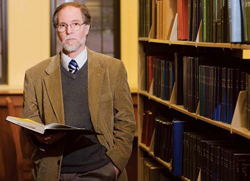Filed Under > Research/Publications
How Can Schools Promote Multicultural Understanding?
Like most Americans in the moments after the terrorist attacks on September 11, 2001, Lou Cristillo's first thoughts were for the safety of his wife and children. It wasn't terrorists that Cristillo, a TC research assistant professor in the Department of International and Transcultural Studies, was worried about, however. Instead, he was afraid his family might be attacked by angry Americans.
That's because Cristillo, who is white and was raised as a Catholic before converting to Islam in the 1980s, is married to a Muslim woman he met in Morocco during his 18 years there working with the Peace Corps and an overseas American school. She wears a head scarf. Their four children have Arabic first names.
"Even before 9/11, my wife got the stares, the sense that people here were suspicious of her, that she and our kids were unwelcome and didn't fit in," he says.
For a week after the attacks, Cristillo's wife, at his urging, put aside her head scarf when she went out. "Finally she said, - 'This is who I am, I am going to wear it.' She felt so self-conscious without it, it was as if she were naked," Cristillo recalls. "But then that same day, someone pulled up in a pickup truck next to her on the street and spat in her face.
"The sad irony in this is that several years before 9/11, my wife, who is dark-complexioned, got called the - 'N-word.' Welcome to America!"
All of which helps explain why Cristillo, with funding from the Ford Foundation, is now conducting a three-year study of Muslim students in New York City public schools. While there is a long history of research in schools to study the effects of assimilation and the mixing of cultures, Cristillo is asking a new and all-too pertinent question: What happens to students whose culture is treated as an enemy of the state?
"You have kids who are anglicizing their names so as not to mark themselves as Muslim or Arabic," Cristillo says. "Many girls have stopped dressing in identifiably Muslim ways. Young adults are trying to pass themselves off as Puerto Ricans or blacks. What impact does that have on their religiosity and on their identity as Americans?"
At the same time, Cristillo believes, 9/11 has produced a racialized religious identity among Muslims. "Everyone's a Muslim now, like it or not," he says. "Even Muslims who are completely secular are treated as highly religious. Women are simply presumed to be submissive objects of male domination. That's the irony: you're confronted with your religiosity whether you're religious or not."
From his previous field work in New York, conducted as part of his dissertation at Teachers College, Cristillo has learned that, in fact, Muslims here are anything but a homogenous group. Among the nearly 600,000 in the New York City area, there is an array of nationalities and ethnicities. Yet that diversity is often overlooked, he says, in part because the media - in a self-fulfilling search for the "stereotypical" Muslim - focus too often on Muslim kids who attend private schools, which are more conservative in their religious orientation.
"The number of students enrolled in Muslim private schools is probably 4,000 at most," he says. "That's about three or four percent of the Muslim school-aged kids in New York. So we're getting a skewed look. We're ignoring the kids going through the Americanization of the public school system. The fact is that one in 10 kids standing in New York City school lunch lines is wondering if the food is Halal."
Cristillo's study will merge findings collected through various means: a large-scale phone interview, a series of focus groups, and the ethnographic research of a TC doctoral student, Ameenah Ghaffar, working inside the schools. Eventually, he hopes to involve 500 Muslim and 300 non-Muslim students in the public school portion of the study, and another 200 students from private Islamic schools. The interviews also include key stakeholders such as principals, teachers and guidance counselors.
"I've been an educator all my life, and I haven't lost my faith in the schools and schooling as a forum where the hardest social issues can be examined and discussed so that we can break down things that foster stereotypes and bigotry," Cristillo says. "The fruits of research, for me, are not just scholarly papers, but also useable findings for classroom teachers to improve their teaching style, course content and classroom methods in ways that promote tolerance for diversity.
"That's really the beauty of Teachers College for me. I don't know any other place in the country that would provide someone like me with the chance to combine classroom teaching with scholarship of this kind, and with all the resources of New York at my disposal. There's just a tremendous sense of possibility - and hope."
Published Wednesday, May. 9, 2007
